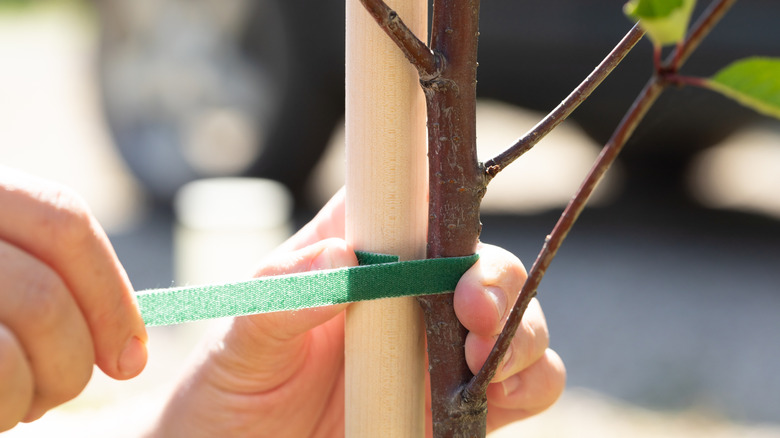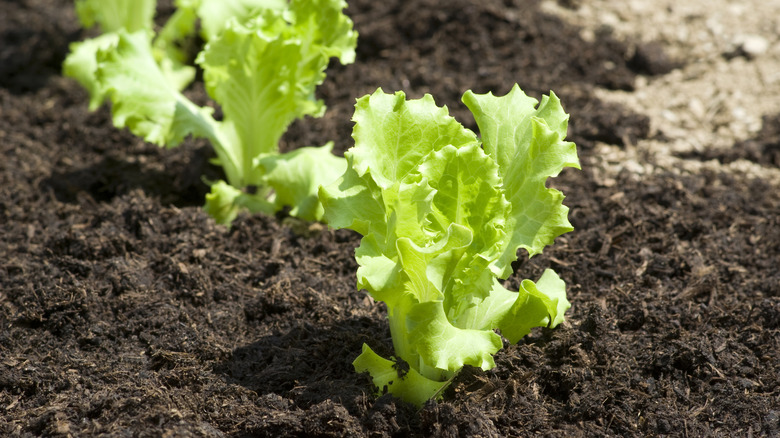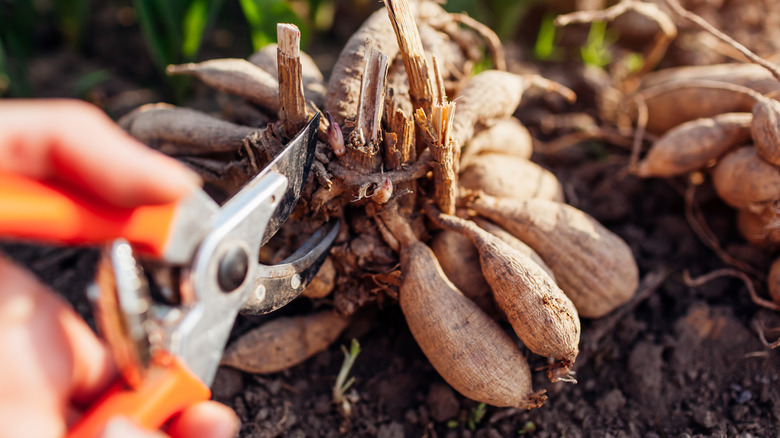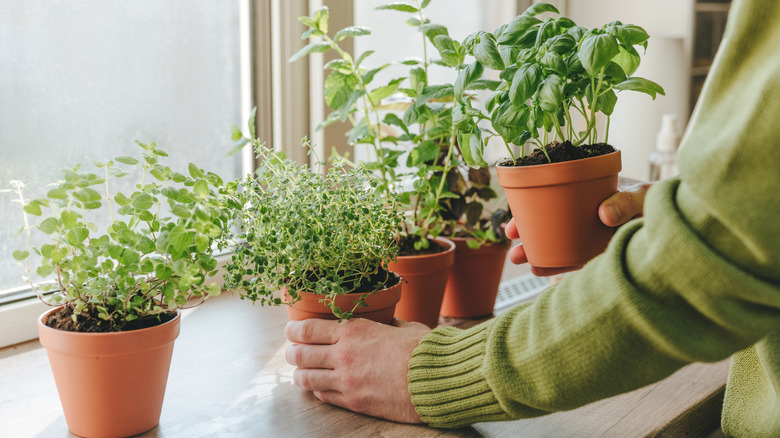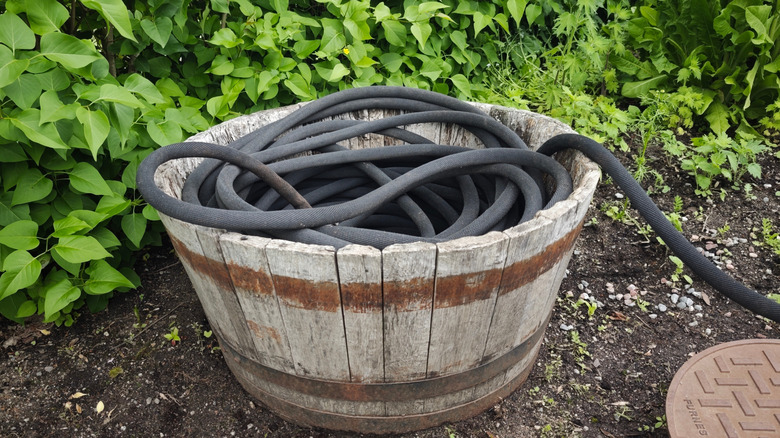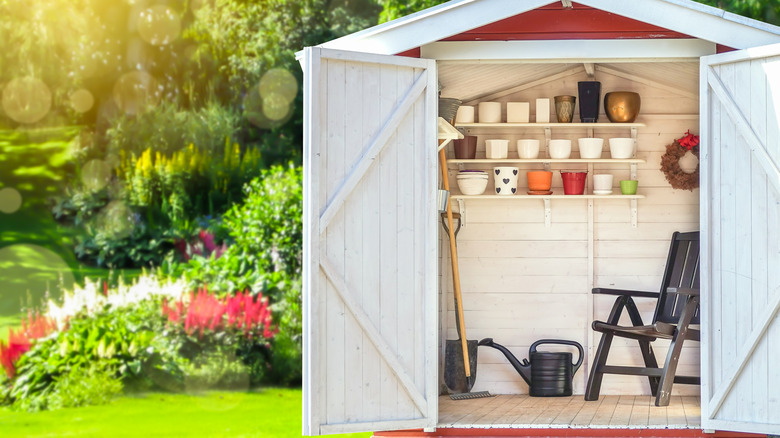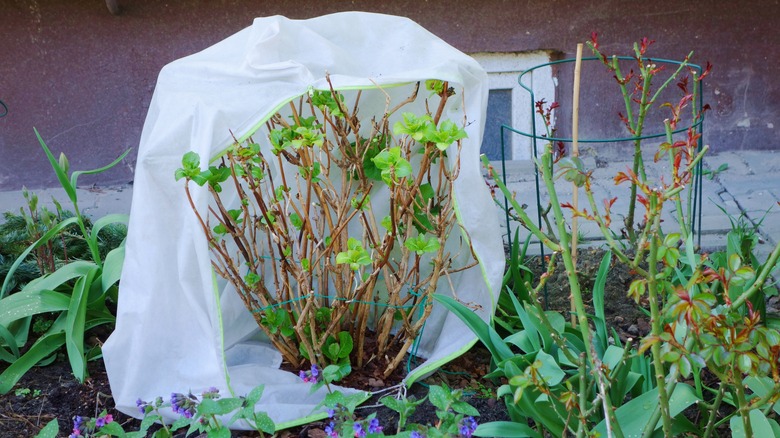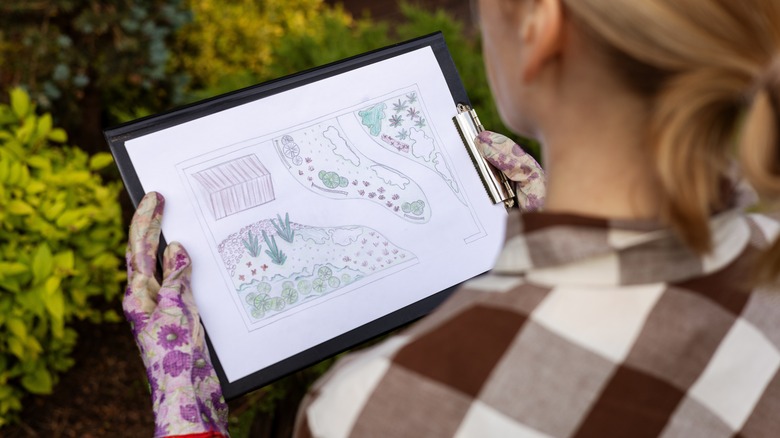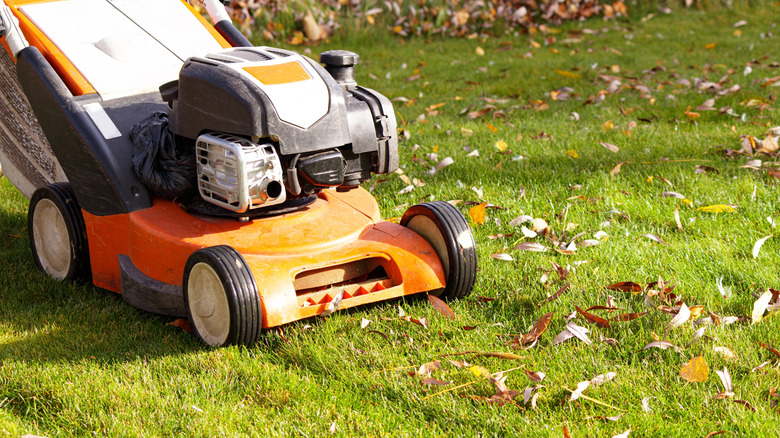The Ultimate Fall Garden Guide: What To Plant, Prune, Propagate, And Plan
We may receive a commission on purchases made from links.
The weather might be getting chilly, but that doesn't mean you're off the hook just yet with your garden. Fall is actually a critical time for your garden because it's when you're setting it up for springtime success. It's also an awesome time to get one last harvest from your plants, so don't close up the shed just yet.
Figuring out what to do now can feel overwhelming just because there are so many options. That's why we've created the ultimate guide for garden chores right as the first frost comes in. We'll go over why each task is critical to do during the fall season and include a few tips for how to work smarter and not harder. Trust us, the more you get these knocked out of the way now, the better your garden is going to look right when you need that burst of color the most to shake off winter doldrums.
Plant stakes and supports for fall-blooming flowers
There's still a whole world of flowers and veggies that can grow in the fall but need a little help. Rather than letting plants and flowers begin to sag or droop, get out the plant stakes and pop them behind your plants to give them a little support. Doing this will give you a beautiful looking autumnal garden that's full of color as one last hurrah before the winter grayness sets in.
Plant stakes come in a variety of types, but we typically prefer metal coated stakes since they tend to hold up for the long-term, especially when compared to wood or plastic. Some will have a ring around the top that supports your plant, like these Kingsyard 16 Inch Plant Support Stakes but we opt for the ones that can be adjusted based on the height of your plant, like HAINANSTRY Adjustable Length Garden Stakes. You can use twine, VELCRO Brand Adjustable Plant Ties, or even twist ties to secure the plant into place, just make sure it's not too tight so that nutrients can easily flow through the plant's cells.
Plant garlic bulbs now for harvesting later
The cool weather of fall makes the perfect climate for garlic to grow, so plant your bulbs now before the ground is too frozen to dig. Garlic requires cold temperatures to grow, and while you might be able to mimic that in an unfinished basement or drafty shed, it's just so much easier to use the weather to your advantage, especially since you've probably got lots of freed-up garden space.
Planting garlic bulbs requires a little finesse as you need to get the timing just right. Plant it too early, and the garlic will germinate, sending vulnerable shoots out of the ground that can succumb to frost damage. On the other hand, planting them too late, you might end up breaking your gardening tools on dirt that's too frozen to break through. Also, you may need to special-order seed garlic, as grocery store garlic often has growth inhibitors sprayed onto it. To plant, break up full cloves into sections and plant them two inches deep with the pointy side up, then cover.
Plant fall-weather veggies
You can still get one more good harvest before the winter sets in, so plant a few cold weather-loving crops while there's still time. Leafy greens like lettuce and kale, brassicas, snow peas, and root vegetables like carrots and radishes can all handle some cool temperatures. However, don't wait too long; a few of these have longer germination periods and so will need time to grow. The shortening days can make it harder to get these crops before the winter frost rolls in. What's cool about cold-weather crops, though — no pun intended — is that some of them can even develop a sweeter taste during the cooler fall, letting you put a flavorful spin on salads, stews, you name it.
So, how do you ensure you get this right? Start by finding your expected frost date; the Farmer's Almanac is a great resource for this. Next, take a seed packet and look for either the "days to maturity" or its equivalent, add a week just in case, then count backward from the frost date. If there's enough time, get to planting. If you're too late, you can always give it a go and see what happens, or start seeds indoors to give them a little warm boost.
Plant cool-weather flowers for a dreary day perk-me-up
Let's say you're not a vegetable garden person, you're prone to seasonal depression, or both — does that mean you're done planting? Not at all, thanks to cool-weather-loving flowers. Pansies (Viola × wittrockiana), Salvia (Salvia spp.), Ornamental kale (Brassica oleracea), and Beautyberry (Callicarpa dichotoma) can all do well in a fall garden. Plus, their bright, cheerful colors can be a big help when the daylight hours get shorter and gray clouds roll in.
If you're planting from seed, the process is the same as veggies: check your frost date, check the maturation date on the seed packet, pad it a week, and get planting. However, you may want to try transplanting seedlings or mature plants if you're cutting it close to the expected frost date or want instant gratification. Just make sure your ground is still soft enough to dig in so that the roots and spread and your tools don't break.
Plant evergreens, deciduous trees, and shrubs
Generally speaking, deciduous trees, shrubs, and evergreens can be transplanted successfully between October 15th and December 1st, so long as your ground is still soft enough to dig into. Deciduous trees do well in the cooler months as transplants because they're dormant and aren't seeking nutrients the way evergreens do. And though it might feel counterintuitive, evergreens should be saved for planting when the soil is warmer, even if that just means a little bit earlier in the fall season.
The key to ensuring your deciduous trees do well after transplant is to give them special attention. Water the ground thoroughly early in the morning so that it soaks in rather than freezing, and mulch around the base for insulation. However, leave a gap between the trunk and the mulch — about two inches — as wet mulch can cause trees to rot when they're in constant contact. You may also want to stake the tree if your area tends to get windy in the winter.
Pull weeds and plant spring flower bulbs in their place
Just because you're closing up shop for the winter doesn't mean the weeds are. In fact, fall might be the perfect time to catch them when they're unsuspecting, as they're settling in for a long winter's nap. Plus, any holes that get created can be repurposed into a spot for spring-blooming bulbs.
Weeding in the fall can be tricky if your ground has begun to freeze, so you may need a heavy duty rake with metal tines to help you out. Opt for one with a blunter head, like Coopvivi's Heavy Duty Garden Rake, instead of a longer one that you'd use for leaves, as these can break when tackling tough soil. When you pull the weed, inspect the area for leftover roots or a deeper taproot, as these can make the weed come back with a vengeance next year. Discard the weed into the trash instead of your compost pile to prevent it from regenerating.
Pull flower bulbs that can't handle the winter weather
Some of our most beautiful blooms – Canna lilies, Dahlias, Gladioli – are too fragile to handle the cold, frozen soil. Their bulbs tend to rot, and since some can get pretty expensive, it's worth the effort of digging them up and storing them inside until the spring. You can either wait until the first frost comes or the bulb's foliage dies back; we tend to prefer the former since each plant is different and can behave unpredictably once frost rolls in.
Cut back any remaining foliage, and carefully dig around the bulb, making sure not to cut off too many roots or bruise the bulb. Lift the bulb out and then remove the soil completely with a good shake and rinse. Lay the bulbs on newspaper, and cover them anywhere from a few days to three weeks, depending on the plant; this is called "curing" the bulb. While they're curing, prepare the storage bed by adding layers of peat moss, sand, and coco coir into a bin that's not air-tight. Set the bulbs about two inches deep, making sure none are touching, then store the container in a spot that stays around 40 degrees Fahrenheit and 50 percent humidity. Take a peek every now and then to make sure rot hasn't found its way in, and remove any diseased-looking or rotting bulbs.
Propagate previously planted bulbs and shrubs
Now that you've dug a few bulbs up, why not get them ready for a bigger spring planting by propagating or dividing them? Propagating bulbs and shrubs in the fall can work well as the plants are dormant and won't need a lot of energy and nutrients to thrive. Once they wake up again in the spring, you'll have more blooms and healthy plants.
Wait until the foliage has died back before dividing your plants or bulbs, but not so long that the ground freezes and you're locked out of digging. Lightly shake off the soil, and inspect for damage, tossing any part of the plant that looks moldy or feels soft. Look for offshoots, and separate them from the mother bulb, then plant everything back in the ground and add a layer of mulch or prepare them for storage if they're too fragile for winter.
Pot up herbs for continued indoor harvesting
Many herbs have Mediterranean origins, so they aren't good at handling the cold temperatures winter brings. But luckily, they can be grown year-round indoors and typically take transplanting well. If you've got an outdoor herb garden, now is the time to take a few cuttings or pot up the whole plant and bring it indoors to keep your spice cabinet flowing.
Healthy herb plants can be propagated from cuttings in water, which is sometimes easier than digging up the entire plant and putting it in a pot; but do whatever is easiest for you and makes sense for your gardening practices. Make sure to inspect the cutting or plant for pests or diseases you don't want indoors, and consider quarantining them for a bit before introducing them to the rest of your indoor plant collection. Once they're ready, set them by a sunny window and treat them the way you would any other houseplant.
Prune late-flowering trees, rose bushes, and spent blooms
Now is the time to get rid of any old growth, dead flowers, and spent stalks. Now that your plants have completed their growth cycle for the year, it's much easier to see branches and stems that might not make it back next season. Plus, you can get really heavy with the pruning shears and lop off as many inches as you want; new growth won't be coming until spring so there's less chance of accidentally chopping off baby stems.
There is one caveat, though: don't prune back things that can give a little winter interest like ornamental grasses or cold-hardy ground covers. Sterilize your shears before you begin to ensure you don't transmit any nasty pathogens, then start by removing dead blooms or damage. For bigger plants, like hedges and shrubs, you'll probably need something more heavy duty like the WORKPROX 20V Cordless Hedge Trimmer.
Put away garden hoses, fountains, and rain barrels
Draining anything that's used to store or move water before the first frost is a piece of critical gardening maintenance that will keep your tools lasting longer. Water barrels, hoses, bird baths — these all can succumb to damage when water freezes. Plastic in particular is prone to failure after a winter freeze since it becomes brittle, and may crack open once the water inside it begins to expand during the spring thaw.
Drain hoses with gravity by first removing them from the spigot then laying them over a deck or patio railing. Water barrels and bird baths can be tipped to their side if light enough, or just open their spigots or drain plug if they have them. To be extra sure you can blast them with an air compressor, then store them in your shed or somewhere dry.
Put away bags of soil, plant pots, and tools
Pots, soil, and gardening tools should also be stored once you're done using them for the season. Clay, plastic, and ceramic pots or tools are particularly vulnerable to cracking or splitting in the winter, so this isn't a chore to skip since they can get pretty expensive to replace. Plus, once spring comes around, you can open your garden shed and see all of your pretty, clean tools and materials ready to get back to work.
Before you store any tools start by cleaning them so that they don't rust over the winter. Close up bags of soil to prevent any pests from wintering inside, and store them somewhere dry. For pots and containers, dump the old soil into your garden, then give them a soapy wash and rinse. Let them dry, then store them in rows, but don't stack them, as it can be hard to get them unstuck when they begin to expand in warmer temps.
Protect trees and shrubs with covers
For shrubs and plants you can't dig up to store inside, it's a good idea to wrap them with a protective covering before the hardcore winter weather rolls in. Not only does it prevent freezing winter winds from ravaging your plant, but covers also create a barrier that ensures deer or shelter-seeking bugs can't break.
Pre-made covers can be purchased for pretty cheap; this two pack of TRIITECH Plant Covers is under $30, or you can DIY it. For DIY frost covers, use natural fabrics so that moisture doesn't get trapped inside, like burlap or cotton sheets. You may also want to give your plant support with a stake if your area has strong winds, just to be safe.
Protect garden beds with a fresh layer of mulch
Mulching around your plants one more time is like giving them a warm, fluffy blanket for their winter snooze session. Mulch protects vulnerable roots from harsh weather conditions and just kinda looks nice, don't you think? Plus, it prevents nutrients in the soil — and the soil itself — from getting blown away since there's no foliage to protect it.
You can use any type of mulch you want, but there is a bit of strategy with fall mulching that will optimize your garden. Start with a layer of compost so that your plants have a little nutrients right when they're ready to wake up. Then cover that with a light layer of mulch or straw. Don't go too heavy with either, as both can trap moisture that can lead to rot.
Plan next year's garden layout
Now that everything is calm and settled, why not start planning next year's layout? The fall and winter are perfect times to reflect over what went well, what didn't, and what you can improve upon next year. That way, you're ready to hit the ground — or soil — running once everything begins to thaw. This is also a good time to get your soil tested if you haven't done so recently, since it will help you understand your soil's makeup and what nutrient boosts your plants might need next year.
Getting a soil test is easy, and most university cooperative extensions will do it for a small fee. While you're waiting for that analysis to come back, take time and write down the plants you grew, their success rates, any tweaks you'd like to make next year (species, growing spot, planting earlier or later, etc.), any disease or pest outbreaks you dealt with, and anything else that comes to mind. The best part is, there are no rules; you can be artistic and draw next year's garden plans or just have a simple Google Sheet or written list — it's whatever works best for you.
Push that lawnmower one more time
Before you close that shed up for good this season, give your lawn one final mow. Long grass tends to get brown and patchy post-thaw, while leaves left to rot over your lawn can lead to rot. However, leaves that have been mulched by your lawnmower can become excellent compost that keeps your garden and lawn healthy.
After mowing, it's a good idea to clean your mower of any grass clumps and oil its parts. Make sure not to store it without drying it off first so that rust doesn't set in while you're not looking. You can also sharpen the blade now if you want, but we like to do it in the spring right before that first satisfying mow of the year.

